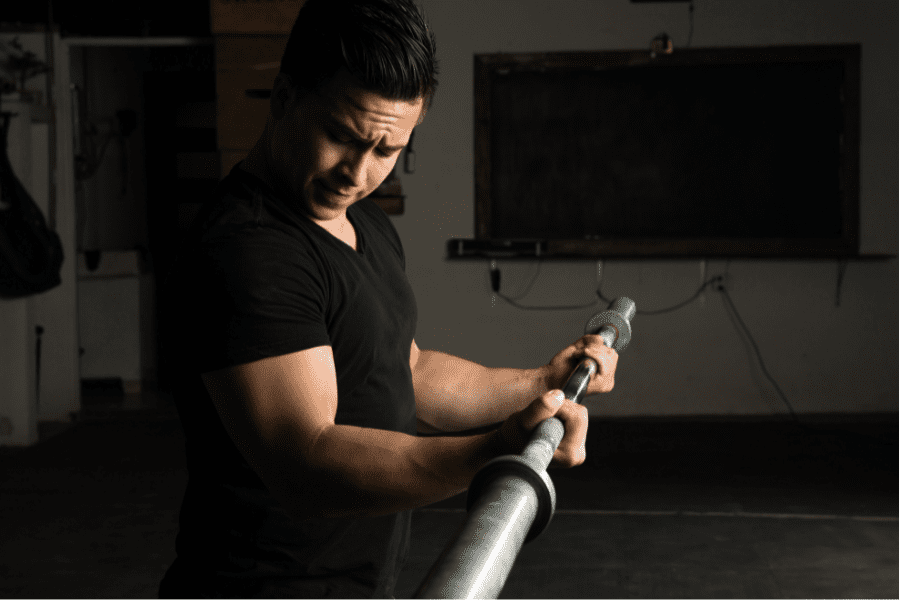Seated DB Hammer Curls (How To, Benefits & Alternatives)
Seated DB Hammer Curls are a great finisher to toast the biceps at the end of a workout. Of course, what biceps exercise isn’t a great choice to finish off a lift?
In this guide I’m going to teach you how to do Seated Dumbbell Hammer Curls, what muscle groups they work and a few alternatives in case you need them.
How To Do Seated Dumbbell Hammer Curls
Equipment Needed
- Flat Bench (although almost any kind of chair or box that you can sit on will work)
- Dumbbells
Instructions
- Start in a seated position on the edge of a bench, knees bent with feet flat on the ground about hip-width apart.
- Hold one dumbbell in each hand and sit tall with good posture. (Raising an adjustable bench to 90 degrees can help with this)
- Start with palms facing in toward the body.
- Now, curl both dumbbells up to shoulder level by flexing the biceps hard. Palms should finish still facing one another. Do not rotate the palm up.
- Squeeze the biceps at the top of the rep and then lower back down to the starting position.
Coaching Points
The biggest mistake I see with Seated Dumbbell Hammer Curls is swinging the dumbbells at the bottom of the rep. Lower the weights down under control and do not swing them at the bottom.
The other mistake I see usually comes when an athlete is trying to use too much weight. Instead of keeping the elbow, they allow the elbow to drift back which turns the movement into more of a row than a curl.
Muscles Worked

Seated Dumbbell Hammer Curls focus almost entirely on the biceps of the upper arms as well as the forearm.
More specifically, Seated Dumbbell Hammer Curls is one of the best biceps exercises to really focus on the Brachioradialis (the forearm muscle that aids in flexing the elbow). It also works the Biceps Brachii and the Brachialis.
Seated DB Hammer Curl Benefits
Here are three benefits of incorporating seated dumbbell hammer curls into your exercise regimen:
Enhanced Arm Strength and Size
Performing Seated Dumbbell Hammer Curls can lead to hypertrophy (muscle growth) and increased strength in the biceps and forearms.
This exercise adds variety to bicep workouts by emphasizing different muscle fibers than traditional curls due to the neutral (hammer) grip. This can lead to more balanced arm development and potentially increase overall arm strength.
Improved Grip Strength
The neutral grip position used in Hammer Curls more actively engages the muscles of the forearms responsible for grip strength. Improved grip strength is beneficial not only for lifting heavier weights but also for daily tasks that involve holding or grasping objects, like opening jars or carrying bags.
Reduced Risk of Injury and Joint Stress
Performing curls in a seated position can help ensure better form and reduce the likelihood of using momentum to lift the weight, which can lead to injury.
Additionally, the hammer grip position tends to be easier on the wrists and elbows compared to the supinated (palms up) grip used in traditional bicep curls, making it a good alternative for individuals who may experience joint pain with supinated movements.
Seated Dumbbell Hammer Curl Variations
Looking to shake up your workout a bit? Here are a couple of Seated Dumbbell Hammer Curl variations.
Seated Alternating Dumbbell Hammer Curls
The simplest variation (and the one most of us probably do anyway) is to alternate curling one arm at a time. It allows you to focus on each arm individually and usually allows you to lift just a little more weight.
Seated Dumbbell Curls

Regular Seated Dumbbell Curls are a simple, but effective Hammer Curl variation. Instead of keeping the palms neutral (facing in), turn and rotate the palms up as you curl the weight. This puts a little more emphasis on the Biceps Brachii (the major biceps muscle).
Hammer Curls
Another variation for seated curls is to just not sit. With Hammer Curls, everything stays the same except they are performed standing up instead of in a seated position.
Seated Dumbbell Hammer Curl Alternatives
If you can’t do Seated Dumbbell Hammer Curls, for whatever reason, here are a couple of alternatives.
Barbell Curl

If you don’t have dumbbells, don’t worry, Barbell Curls are a perfect (some would even say better) alternative to their dumbbell cousin.
Stand tall, grip the bar shoulder-width apart, keep elbows tucked and curl the bar up to shoulder level. Slowly lower back to the starting position and repeat for the desired number of reps.
Band Curls
If you’re traveling or on vacation and all you have is a resistance band, you can give Band Curls a try.
Stand on one end of a resistance band and grab the other end with both hands. With Band Curls, you can use the same neutral grip by keeping your palms facing each other.
If you have an issue that is hindering your ability to grip, band curls can be a great alternative because you drape the band over the hand or even the wrist and eliminate the need to grip a dumbbell or barbell.

Online Strength Programs
- 1-on-1 Online Coaching
- Sports Performance Programs for Football, Basketball, Soccer & More
- Programs for Former Athletes (Legends) Who Still Want to Train Like Athletes
- Programs for Adults Who Want to Get Healthy (and look great at the beach!)
- Use Code “HB10” to Get 10% Off Today
More Links and Info
If you need more Curl ideas, head over to the Arm Farm within the Exercise Library where you’ll find more exercises to get that great Bicep pump.

